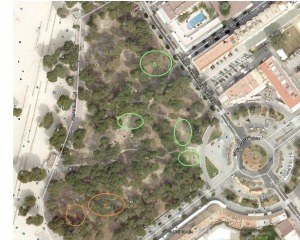The Town Hall of Calvià starts the reforestation and conditioning of pine tree area (pinada) of Santa Ponça to ensure its preservation.

THE TOWN HALL OF CALVIÀ STARTS THE REFORESTATION AND CONDITIONING OF PINE TREE AREA (PINADA) OF SANTA PONÇA TO ENSURE ITS PRESERVATION
The performance will take place in various phases
The Calvia Town Hall, through the Department of Natural Environment and Urban and Maintenance has begun the reforestation and conditioning process of the pine tree area (pinada) of Santa Ponça.
In many places in the municipality of Calvia natural ecosystems have been transformed because of different causes (forest fires, opening of roads, etc.) so that it is increasingly common to find communities that have replaced the original, that in most cases had a higher environmental value.
In the Santa Ponça case, the ecosystems that have been most significantly affected are sandbanks (dune systems) has led to the decline of the dunes that ensure the contribution of sediment to the beaches, besides having an important landscape value. Currently, only a small area in the existing dune system can be found that existed before the pine forest of Santa Ponsa and therefore it is considered a conservation priority.
With the aim of achieving the conservation of natural areas of high environmental value and within the scope of this project, reforestation work is suggested (mastic trees, pines and tamarinds) and also work in several specific areas in the pine forest of Santa Ponsa. Furthermore, the negative effects of human presence are going to be minimized by protection perimeters in some places (mainly where the reforestation tasks are carried out), and thus avoiding any possible vehicle presence during the celebration of some recreational and cultural events held traditionally in the pine forest.
The process will take place in phases. The first phase involves the reforestation of two very degraded areas near the main entrance and near the roundabout (marked as zones 1 and 2 on the map), with pine trees of a certain size and mastic trees, establishing a protection perimeter to prevent any possible damage to the trees during the celebration of some of the activities that take place there.
A second stage includes substratum replenishment to the two dunes on the side of the pine forest, parallel to Avda. Rey Jaume I (marked as areas 3 and 4 on the map), to cover part of the exposed roots of some pine tree specimens.
And one last phase will involve the reforestation of two other highly degraded areas located, one next to the entrance from Balneario street (marked as zone 5) and another area, also very degraded, near the tourist office (marked as zone 6). In zone 5 pine and tamarind planting is suggested, since there is currently a group of these trees. In zone 6 pine and mastic tree plantation is suggested, establishing in both cases, the same as in zones 1 and 2, a protective perimeter.




